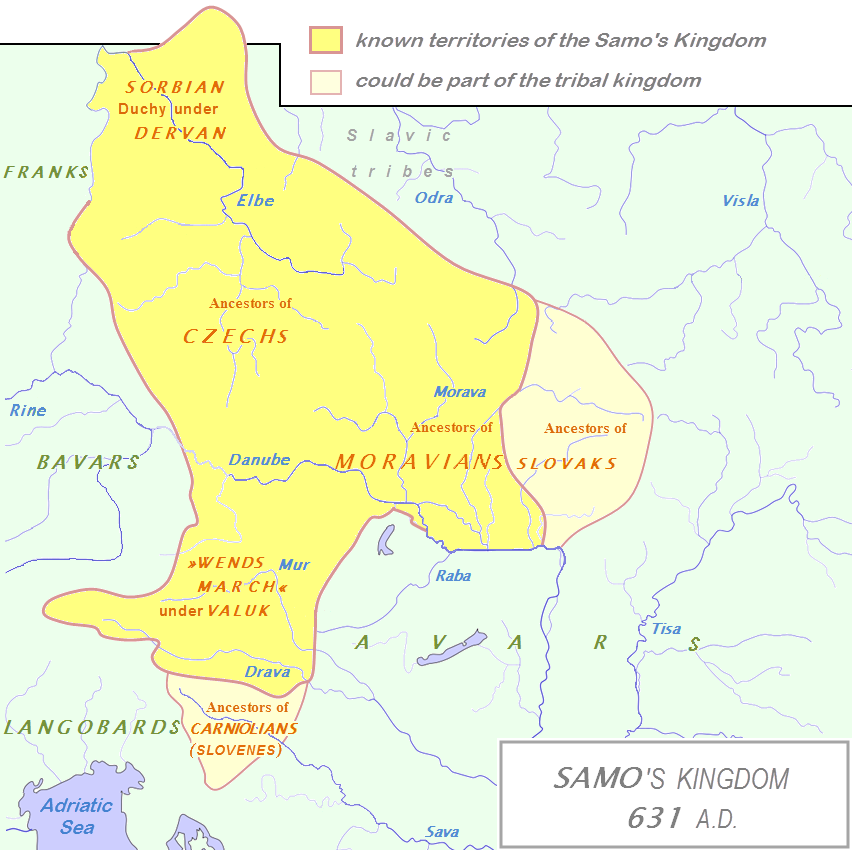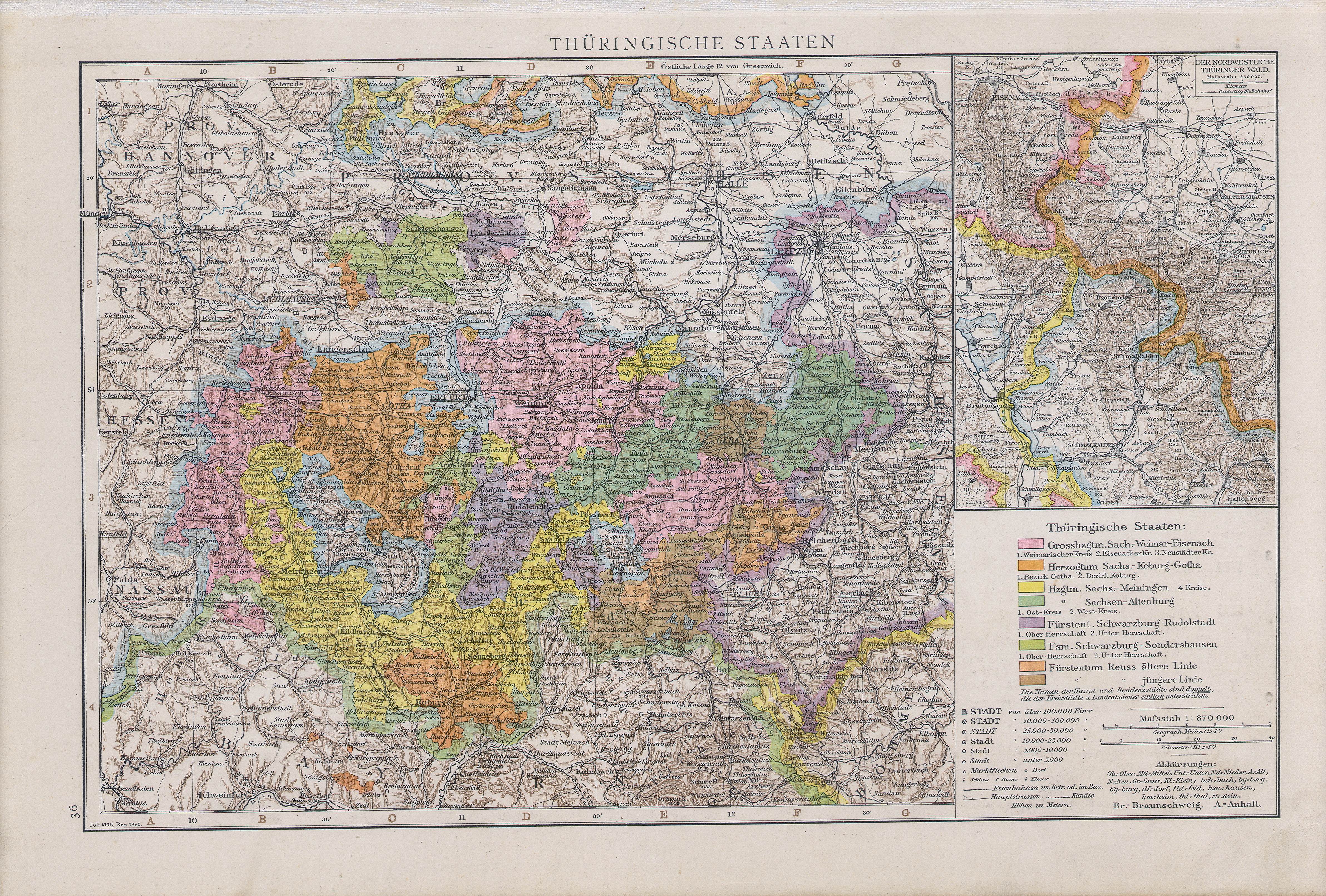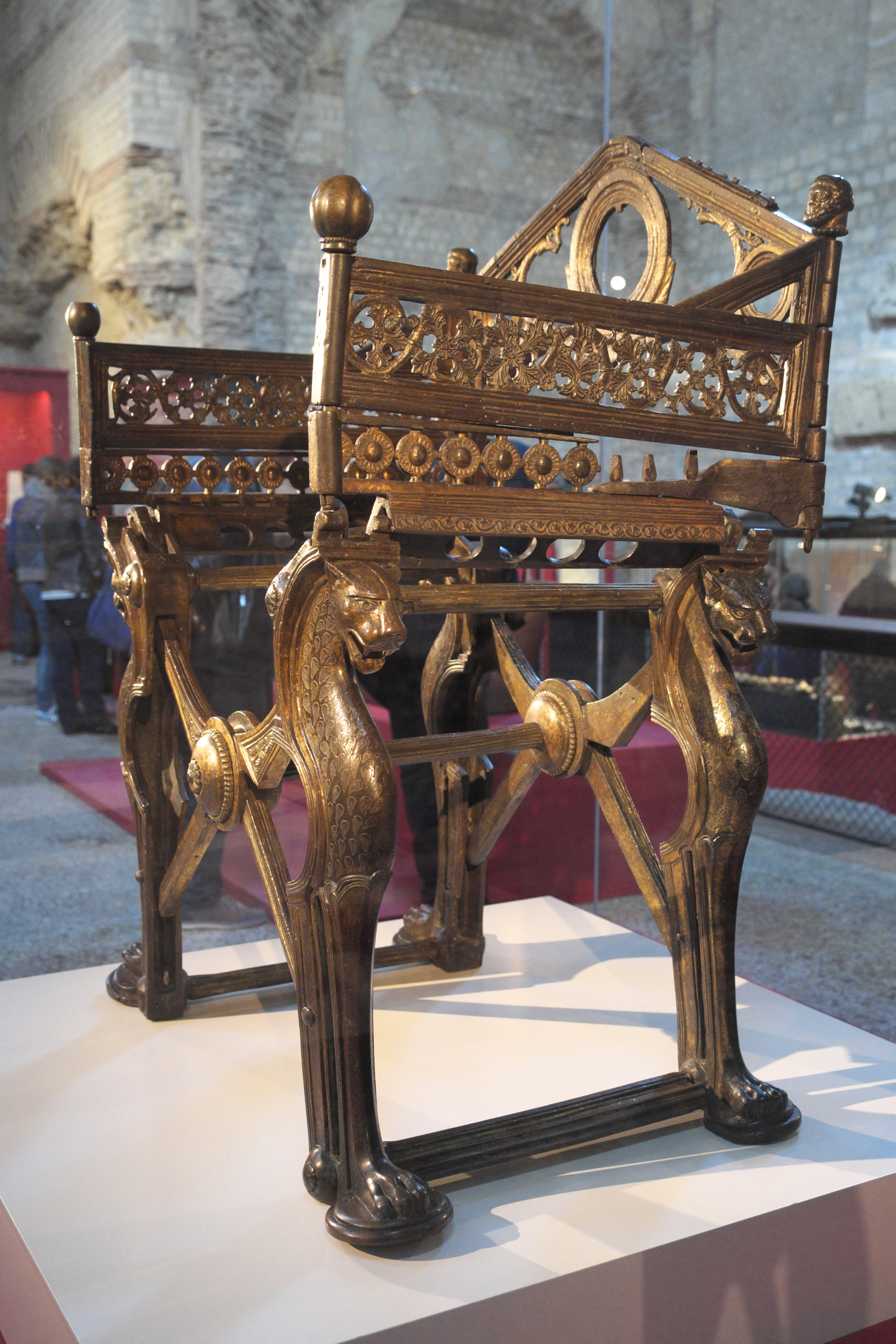|
Samo Wah
Samo (–) founded the first recorded political union of Slavic tribes, known as Samo's Empire (''realm'', ''kingdom'', or ''tribal union''), stretching from Silesia to present-day Slovakia, ruling from 623 until his death in 658. According to Fredegarius, the only contemporary source, Samo was a Frankish merchant who unified several Slavic tribes against robber raids and violence by nearby settled Avars, showing such bravery and command skills in battle that he was elected as the "Slavic king" ( la, rex Sclavorum). In 631, Samo successfully defended his realm against the Frankish Kingdom in the three-day Battle of Wogastisburg. Reign The dates for Samo's rule are based on Fredegar, who says that he went to the Slavs in the fortieth year of Chlothar II (i.e., 623–24) and reigned for thirty five years.Curta, 109. The interpretation that places the start of Samo's reign in the year of Fredegar's arrival has been questioned on the basis that the Wends would have mo ... [...More Info...] [...Related Items...] OR: [Wikipedia] [Google] [Baidu] |
Rex Sclavorum
King of the Slavs ( la, rex Sclavorum, Sclavorum rex) was a title denoting some Slavic rulers, as well as Germanic rulers that conquered Slavs, in the Middle Ages in European sources, such as Papal correspondence. Papal use is bolded. ;Slavic *Samo, ruler of Slavs (623–658); in the Frankish Annals *Drogoviz, ruler of the Veleti (789); in ''Annales Mettenses priores'' in 805 *Trpimir I of Croatia, Trpimir I, ruler of Croatia (845–864); erroneously by Gottschalk of Orbais, Gottschalk in the 840s *Svatopluk I of Moravia, ruler of Moravia (870–894); by Pope Stephen V in 885 *Michael of Zahumlje, Michael, ruler of Zahumlje (913–926); erroneously in the ''Annales Barenses'' *Mihailo Vojislavljević, ruler of Duklja (1050–1081); by Pope Gregory VII in 1077 *Bodin Vojislavljević, ruler of Duklja (1081–1101); by the chronicle of Orderic Vitalis, relating to events of 1096 *Stefan Dragutin, ruler of Serbia (1276–1282) and Syrmia (1282–1316); by Pope Nicholas IV in 1288 ;No ... [...More Info...] [...Related Items...] OR: [Wikipedia] [Google] [Baidu] |
Khagan
Khagan or Qaghan (Mongolian:; or ''Khagan''; otk, 𐰴𐰍𐰣 ), or , tr, Kağan or ; ug, قاغان, Qaghan, Mongolian Script: ; or ; fa, خاقان ''Khāqān'', alternatively spelled Kağan, Kagan, Khaghan, Kaghan, Khakan, Khakhan, Khaqan, Xagahn, Qaghan, Chagan, Қан, or Kha'an is a title of imperial rank in the Turkic, Mongolic and some other languages, equal to the status of emperor and someone who rules a khaganate (empire). The female equivalent is Khatun. It may also be translated as " Khan of Khans", equivalent to King of Kings. In Bulgarian, the title became known as ''Khan'', while in modern Turkic, the title became ''Khaan'' with the ''g'' sound becoming almost silent or non-existent; the ''ğ'' in modern Turkish ''Kağan'' is also silent. Since the division of the Mongol Empire, monarchs of the Yuan dynasty and the Northern Yuan held the title of ''Khagan''. ''Kağan, Hakan'' and ''Kaan'', Turkish equivalents of the title are common Turkish names ... [...More Info...] [...Related Items...] OR: [Wikipedia] [Google] [Baidu] |
Fredegarii Chronicon
The ''Chronicle of Fredegar'' is the conventional title used for a 7th-century Frankish chronicle that was probably written in Burgundy. The author is unknown and the attribution to Fredegar dates only from the 16th century. The chronicle begins with the creation of the world and ends in AD 642. There are also a few references to events up to 658. Some copies of the manuscript contain an abridged version of the chronicle up to the date of 642, but include additional sections written under the Carolingian dynasty that end with the death of Pepin the Short in 768. The ''Chronicle of Fredegar'' with its ''Continuations'' is one of the few sources that provide information on the Merovingian dynasty for the period after 591 when Gregory of Tours' the ''Decem Libri Historiarum'' finishes. Authorship None of the surviving manuscripts specify the name of the author. The name "Fredegar" (modern French Frédégaire) was first used for the chronicle in 1579 by Claude Fauchet in his '' ... [...More Info...] [...Related Items...] OR: [Wikipedia] [Google] [Baidu] |
Sigebert III
Sigebert III ( 630–656) was the Merovingian king of Austrasia from 633 to his death around 656. He was described as the first Merovingian ''roi fainéant'' —do-nothing king—, in effect the mayor of the palace ruling the kingdom throughout his reign. However he lived a pious Christian life and was later sanctified, being remembered as Saint Sigebert of Austrasia in the Roman Catholic Church and Eastern Orthodox Church. Life Sigebert was born in 630 as the eldest son of Dagobert I, King of the Franks, and his concubine Ragnetrude. The king recalled and made peace with Saint Amand, who was previously banished for criticizing the king's vices, and asked him to baptize his new-born son. The ceremony was performed at Orléans and Charibert II, Dagobert's half-brother who was King of Aquitaine at the time, was the god-father. Dagobert assigned the education of Sigebert to Pepin of Landen, who was the mayor of the palace in Austrasia under his father Chlotar II, until 629. P ... [...More Info...] [...Related Items...] OR: [Wikipedia] [Google] [Baidu] |
Radulf, King Of Thuringia
Radulf was the List of rulers of Thuringia, Duke of Thuringia (''dux Thoringiae'') from 632 or 633 (certainly before 634) until his death after 642. According to the Chronicle of Fredegar, he was a son of one Chamar, a Franks, Frankish aristocrat, and rose to power under the Merovingian dynasty, Merovingian king Dagobert I, who appointed him as ''dux'' in the former Thuringian kingdom which Francia had conquered in 531. His installation was meant to protect the eastern border of the Frankish realm against the threatening Wends under Samo, who had defeated the king at the 631 Battle of Wogastisburg and formed an alliance with Dervan, prince of the Sorbs, Sorbian tribes settling in the adjacent region east of the Saale river. Radulf fought successfully against the Slavs, but subsequently refused the incorporation of the secured territories into the Austrasian kingdom. To retain his independence he allied with Fara, a descendant of the powerful Agilolfings, Agilolfing dynasty in His ... [...More Info...] [...Related Items...] OR: [Wikipedia] [Google] [Baidu] |
Duke Of Thuringia
This is a list of the rulers of Thuringia, a historical and political region of Central Germany. Kings of Thuringia *450–500 Bisinus *500–530 Baderich *500–530 Berthachar *500–531 Herminafried :''Conquered by the Franks.'' Frankish dukes of Thuringia ;Merovingian dukes *632–642 Radulf I, "King of Thuringia" after 641 *642–687 Heden I *687–689 Gozbert *689–719 Heden II, son ;Carolingian dukes *849–873 Thachulf, Margrave of the Sorbian March *874–880 Radulf II, son *880–892 Poppo, House of Babenberg, ''dux Thuringorum'' in 892, deposed **882–886 Egino, brother *892–906 Conrad, ancestor of the Conradiner dynasty *907–908 Burchard, last duke, killed in battle against the Hungarians ;Ruled by the Margraves of Meissen *1000–1002 Eckard I, Margrave of Meissen since 985, assassinated *1002–1003 William II, Count of Weimar *1046–1062 William IV, grandson, Margrave of Meissen *1062–1067 Otto, brother, Margrave of Meissen * ... [...More Info...] [...Related Items...] OR: [Wikipedia] [Google] [Baidu] |
Dervan
Dervan or Derwan ( sr-cyr, Дерван, la, Dervanus) was an early duke of the Sorbs ( fl. 615–636). According to some historians and Emperor Constantine VII, Dervan was brother of the Unknown Archon, but some historians also think that Dervan may be his father, which is less likely. According to Serbian academic Tibor Živković, the migration could take place between 629 and 632, before Dervan joined Samo. He is mentioned by Fredegar in his Latin chronicle as ''dux gente Surbiorum que ex genere Sclavinorum'':Making of the Slavs, page 331 "ruler of the people of the ''Surbi'' (Sorb autonym: ''Serbja'', Serb autonym: ''Srbi'') from the nation of the Sclavenians".Curta, 109. He is the first ruler of the tribe mentioned by name. Fredegar records him being subordinate to the Franks for a long time and then joining the Slavic union of Samo. After the defeat of the Frankish king Dagobert I by king Samo near Wogastisburg in 631 or 632, Dervan declared independence from the F ... [...More Info...] [...Related Items...] OR: [Wikipedia] [Google] [Baidu] |
Sorbs
Sorbs ( hsb, Serbja, dsb, Serby, german: Sorben; also known as Lusatians, Lusatian Serbs and Wends) are a indigenous West Slavic ethnic group predominantly inhabiting the parts of Lusatia located in the German states of Saxony and Brandenburg. Sorbs traditionally speak the Sorbian languages (also known as "Wendish" and "Lusatian"), which are closely related to Czech, Polish, Kashubian, Silesian, and Slovak. Upper Sorbian and Lower Sorbian are officially recognized minority languages in Germany. Due to a gradual and increasing assimilation between the 17th and 20th centuries, virtually all Sorbs also spoke German by the early 20th century. In the newly created German nation state of the late 19th and early 20th centuries, policies were implemented in an effort to Germanize the Sorbs. These policies reached their climax under the Nazi regime, who denied the existence of the Sorbs as a distinct Slavic people by referring to them as "Sorbian-speaking Germans". The communit ... [...More Info...] [...Related Items...] OR: [Wikipedia] [Google] [Baidu] |
Thuringia
Thuringia (; german: Thüringen ), officially the Free State of Thuringia ( ), is a state of central Germany, covering , the sixth smallest of the sixteen German states. It has a population of about 2.1 million. Erfurt is the capital and largest city. Other cities are Jena, Gera and Weimar. Thuringia is bordered by Bavaria, Hesse, Lower Saxony, Saxony-Anhalt, and Saxony. It has been known as "the green heart of Germany" () from the late 19th century due to its broad, dense forest. Most of Thuringia is in the Saale drainage basin, a left-bank tributary of the Elbe. Thuringia is home to the Rennsteig, Germany's best-known hiking trail. Its winter resort of Oberhof makes it a well-equipped winter sports destination – half of Germany's 136 Winter Olympic gold medals had been won by Thuringian athletes as of 2014. Thuringia was favoured by or was the birthplace of three key intellectuals and leaders in the arts: Johann Sebastian Bach, Johann Wolfgang von Goethe, and Fried ... [...More Info...] [...Related Items...] OR: [Wikipedia] [Google] [Baidu] |
Latin Language
Latin (, or , ) is a classical language belonging to the Italic languages, Italic branch of the Indo-European languages. Latin was originally a dialect spoken in the lower Tiber area (then known as Latium) around present-day Rome, but through the power of the Roman Republic it became the dominant language in the Italy (geographical region), Italian region and subsequently throughout the Roman Empire. Even after the Fall of the Western Roman Empire, fall of Western Rome, Latin remained the common language of international communication, science, scholarship and academia in Europe until well into the 18th century, when other regional vernaculars (including its own descendants, the Romance languages) supplanted it in common academic and political usage, and it eventually became a dead language in the modern linguistic definition. Latin is a fusional language, highly inflected language, with three distinct grammatical gender, genders (masculine, feminine, and neuter), six or seven ... [...More Info...] [...Related Items...] OR: [Wikipedia] [Google] [Baidu] |
Austrasia
Austrasia was a territory which formed the north-eastern section of the Merovingian Kingdom of the Franks during the 6th to 8th centuries. It was centred on the Meuse, Middle Rhine and the Moselle rivers, and was the original territory of the Franks, including both the so-called Salians and Rhineland Franks, which Clovis I conquered after first taking control of the bordering part of Roman Gaul, now northern France, which is sometimes described in this period as Neustria. In 561, Austrasia became a separate kingdom within the Frankish kingdom and was ruled by Sigebert I. In the 7th and 8th centuries it was the powerbase from which the Carolingians, originally mayors of the palace of Austrasia, took over the rule of all Franks, all of Gaul, most of Germany, and northern Italy. After this period of unification, the now larger Frankish empire was once again divided between eastern and western sub-kingdoms, with the new version of the eastern kingdom eventually becoming the foun ... [...More Info...] [...Related Items...] OR: [Wikipedia] [Google] [Baidu] |
Dagobert I
Dagobert I ( la, Dagobertus; 605/603 – 19 January 639 AD) was the king of Austrasia (623–634), king of all the Franks (629–634), and king of Neustria and Burgundy (629–639). He has been described as the last king of the Merovingian dynasty to wield any real royal power. Dagobert was the first of the Frankish kings to be buried in the royal tombs at Saint Denis Basilica. Rule in Austrasia Dagobert was the eldest son of Chlothar II and Haldetrude (575–604) and the grandson of Fredegund. Chlothar had reigned alone over all the Franks since 613. In 622, Chlothar made Dagobert king of Austrasia, almost certainly to bind the Austrasian nobility to the ruling Franks. As a child, Dagobert lived under the care of the Carolingian dynasty forebears and Austrasian magnates, Arnulf of Metz and Pepin of Landen. Chlothar attempted to manage the unstable alliances he had with other noble families throughout much of Dagobert's reign. When Chlothar granted Austrasia to Dagobert, he ... [...More Info...] [...Related Items...] OR: [Wikipedia] [Google] [Baidu] |








